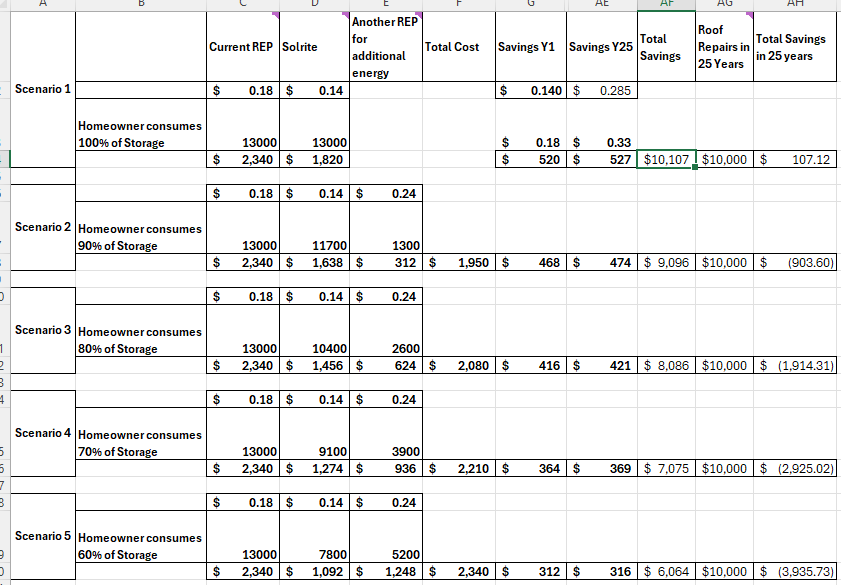How Solrite and Sonnen are changing the discussion on VPPs with VPA.
A DFW Metro Area homeowner can see savings over a 25-year contract even with additional energy costs, but factoring in roof repair-related solar panel removal costs eliminates those savings.
There was a lot of buzz around the Solrite plus Sonnen VPAs recently. Solrite is not offering this VPA option in all states, it is only offering in Texas, California and Puerto Rico, according to its website.
VPPs are Virtual Power Plants. What Solrite is offering is a VPA - Virtual Power Plant Agreement. A Power Purchase Agreement (PPA) with a VPP.
Solrite Sonnen VPA are targeting 1,000 homes and 40 MWh of battery storage, according to Canary Media.
As Doug Lewin of Stoic Energy posts on X, some natural gas plants are dropping out of Texas Energy Fund. So, this Solar+Storage VPA comes at the right time for Texas grid.
Here are the key takeaways from my experience with a homeowner regarding the installation of the Solrite and Sonnen system in the DFW Metro Area.
Some basic facts about this Solrite and Sonnen system:
The PV system is 8 kW, and the Storage system is 40 kWh. The 40-kWh storage system translates into 5 hours of solar energy.
Possibly more than 5 hours because the battery will power designated circuits only, not the entire home. This is typical. During a “back up power” mode, a homeowner is typically concerned about refrigeration (so that food doesn’t spoil) and some lights not clothes washes and dryer.
The homeowner consumes approximately a little over the average annual energy consumption in the US. The solar plus storage system would be perfect for meeting the daily average energy consumption on a sunny day. The storage system would be designed to store renewable energy from the sun during the day because most daytime consumption is lower than peak evening consumption.
Source: Sonnen
The most attractive feature of Solrite’s VPA is that the homeowner's upfront cost is zero. Still, the total cost of the system for this system (Solrite calls it a system prepayment price) is slightly over $25,000. I am assuming the price of the PV system is $16,000 if it is $2 per watt after the Inflation Reduction Act incentives. This means the storage system’s price is $9,000. Hence, if we assume the PV cost is $2 per watt, then the Storage cost is $225 per kWh. Which seems in sync with a couple of estimates I found on the internet. https://8msolar.com/sonnencore-battery-review/ and https://www.cnet.com/home/energy-and-utilities/sonnen-battery-review/
I assumed 8 kW solar system costs $16,000 - $2,000 per kW. That is 9 times cheaper than a small modular reactor! On the other hand, a natural gas plant costs only $820 per kW. Meaning, the solar system costs nearly 2.5 times the cost of a natural gas plant.
But gas plants take years to build and need gas pipeline infrastructure.
“The first small modular reactor at the Clinch River Site near Oak Ridge could cost $17,949 per kilowatt, or around $5.4 billion for a 300 megawatt plant before tax credits or potential interest costs, according to data in a draft of TVA's 2025 Integrated Resource Plan.” Source: https://www.knoxnews.com/story/money/business/2024/09/27/tennessee-valley-authority-small-nuclear-reactors-could-cost-billions/74894512007/
The contract also includes a system buyout price of $24,000 starting in year 6 of the 25-year contract. The system buyout price and the system prepayment price are the same in years 6-25. Solrite wants to ensure the homeowner stays with the contract for at least 6 years so that Solrite or the LLC that serves as the Retail Electric Provider (REP) can recoup the upfront investment and the tax incentives. This is typical based on my experience with solar Power Purchase Agreements (PPAs).
The most bothersome aspect of this Solrite contract that I found was the 2-year look back to calculate the guaranteed output. Solar PPAs typically include a solar production guarantee. In Solrite’s PPA, there is a 12 cents credit to the homeowner if the guaranteed output is not met but that’s calculated at the end of year 2 and every 2 years after. The contract states that “[t]he actual credit rate will be the weighted average $/kWh for the applicable 24-month period.” I think it is typical to assess the guaranteed output annually, not bi-annually.
With a 12-cent rate for buying power with the Solar + Storage system compared to an 18-cent rate with an existing REP, the deal has a good starting point. But the issue is with the roof repair costs alone because the rate at which any additional energy will be charged is 12 cents.
For example, if 33 kWh was the average daily energy consumption and since the battery is sized for 40 kWh, on most days, there will be excess energy flowing to the ERCOT grid. However, the homeowner does not benefit from that because that excess energy revenue goes towards the Solrite-approved REP. This REP sells that excess energy to the ERCOT grid12.
But suppose most of the energy consumption occurs in the evening or nighttime hours and the battery does not have enough juice. In that case, the homeowner must depend on a Solrite-approved REP for this “additional energy.” My understanding as of 07/01/25 is, the new REP partner for Solrite is Abundance, and they are providing an all-in rate of 12 cents.
At the current REP rate of 18 cents, the homeowner’s cost is $0.18 per kWh *13,000 kWh = $2,340. But with Solrite system rate of 12 cents, the cost to the homeowner is $1,560 — annual savings of $780. For a 25-year contract, this is $19,587.
See detailed calculations in the table below – if the new REP charges on average 18 cents (starts at 12 cents and escalates 3%), there are still savings for the homeowner.
This chart below has been updated, see below -
Source: Rao Konidena
Here is the updated chart as of 07/01/25, I am keeping the previous chart for readers who had the previous post -
A different view of looking at this is shown below - the homeowner has a 5-year contract with the current REP at 18 cents. That explains the dip in savings in Year 5. The Solrite initial rate of 12 cents includes a price escalation of 3%. I assumed the Solrite-approved REP charges an initial rate of 12 cents and escalates at 3%. That provides me with an average price of 18 cents per kWh for additional energy the homeowner consumes beyond the stored energy in the battery.
Source: Rao Konidena
Source: Rao Konidena (Updated chart as of 07/01/25)
Another hiccup in this Solrite+Sonnen Virtual Power Plant setup is that the homeowner is responsible for the cost of moving the solar panels in the future in the event of roof repairs. I am unsure whether most homeowners insurance covers the cost of roof repairs that have solar panels. Assuming two instances of $5,000 each (a total of $10,000) for the cost of replacing the solar panels when the roof is replaced during the 25 years reduced the cost savings for the homeowner. I assumed $5,000 for each instance of moving solar panels because this 8 kW had 20 panels.
Source: Fixr
This website states most homeowners insurance would cover the cost of solar panels but I think that might increase the premiums. See “A new report from LendingTree found that in Texas home insurance rates have increased by 54.5% over the past five years.” [Source:https://www.houstonpublicmedia.org/articles/shows/houston-matters/2024/06/10/490049/texas-homeowners-insurance-rates-increased-heres-why/ ]
In summary, Solrite+Sonnen has a good VPA model. Still, the devil is in the details about the roof repair costs associated with solar panels. If Solrite+Sonnen VPA can assure homeowners about this roofing concern, then, I think there could be more homeowners in the VPA.
Energy prices are capped at $5000 per MWh, which translates to $5 per kWh.
See “Current PUCT rules cap wholesale electricity offers at $5,000 per MWh. This “offer cap,” also known as the high system-wide offer cap (HCAP), is a cap on the price at which generators can offer wholesale electricity to retail electric providers that serve and bill individual customers.”
But the energy price cap does not stay at $5 per kWh, it reduces to $2 per kWh under the Emergency Pricing Program (EPP).
Source - https://ftp.puc.texas.gov/public/puct-info/agency/resources/pubs/news/2023/PUCT_Approves_New_Price_Protections_for_Consumers_During_Power_Emergencies.pdf
If the excess energy is 30% of the solar system, 30% of 8 kW times 5 hours times 365 = 4.4 MWh/year. This 4.4 MWh/year times the $5,000 per MWh = $21,900 per year excess energy revenue for the Solrite-approved REP. So, 87.6% of the system pre-payment price could be recovered by Solrite whenever the excess energy by the homeowner reaches that magic # of 4.4 MWh per year. This could explain why there is no upfront cost to the homeowner. If ERCOT market conditions allow, Solrite could recover its investment whenever the excess energy from the homeowner’s system reaches 4.4 MWh. [Source for 5 peak sun hours in TX - https://www.turbinegenerator.org/solar/texas/]









Thank you for this summary. This is extremely good review. It does a great job of braking it all down. I am in a similar business. And understand solar and battery charging systems. Also most people do not understand that the price per kW is not the only cost you pay. The true cost has to include PUC and line charges. Not all companies and plans are the same. THE TRUTH IS IN THE DETAILS.
Thank you for this summary! We're currently looking at this system and I was hoping to get some insight...really appreciate this.